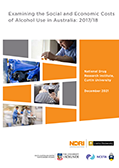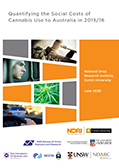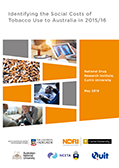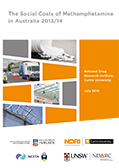Social and Economic Costs of Substance Use
The Social and Economic Costs of Substance Use program is a series of reports estimating the overall costs to Australia from the use of specific licit and illicit drugs. While each report used similar approaches, methods have been tailored to use the most recent and comprehensive data sources for each substance. Therefore, direct comparison of the costs for different substances should only be made in consideration of the specific data available in determining those costs. Funded by the Australian Government Department of Health, each research report was coordinated by NDRI with the collaboration of key experts from around Australia.
 Examining the Social and Economic Costs of Alcohol Use in Australia: 2017/18
Examining the Social and Economic Costs of Alcohol Use in Australia: 2017/18
Examining the Social and Economic Costs of Alcohol Use in Australia was published in December 2021 and reported on the costs incurred during the 2017/18 financial year. It was estimated that the overall cost of alcohol use was $66.8 billion, with 5,219 deaths caused by alcohol in that year. Tangible costs accounted for $18.2 billion, with intangible costs amounting to $48.6 billion (e.g. lost quality of life from poor health). The major domains for tangible costs were workplace ($4.0 billion from absenteeism and injury), crime ($3.1 billion), health care ($2.8 billion, in particular through in-patient care) and road traffic crashes ($2.4 billion). A further $2.6 billion was attributed to the tangible costs of premature death. The intangible costs of alcohol were dominated by premature mortality, with the lost years of life valued at $25.9 billion, with a further $20.7 billion from the lost quality of life for those with alcohol dependence.
 Quantifying the Social Costs of Cannabis Use to Australia in 2015/16
Quantifying the Social Costs of Cannabis Use to Australia in 2015/16
The ‘Social Costs of Cannabis Use to Australia’ report was published in June 2020 and reported on costs incurred in the 2015/16 financial year. Overall, the cost of cannabis use was estimated at $4.5 billion: $4.4 billion in direct tangible costs, including through crime and criminal justice, hospital and other health care costs, reduced productivity and worker absence, and road traffic crashes. The criminal justice system accounted for more than half of all tangible costs. A further $100 million was estimated for intangible costs due to premature death, mostly through cannabis-related road traffic crashes, resulting in more than 850 years of life lost.
 Quantifying the Social Costs of Pharmaceutical Opioid Misuse and Illicit Opioid Use to Australia in 2015/16
Quantifying the Social Costs of Pharmaceutical Opioid Misuse and Illicit Opioid Use to Australia in 2015/16
The ‘Social Cost of Opioids’ report was published in February 2020 and considered the costs incurred in the 2015/16 financial year. The report addressed extra-medical opioid use, which includes the illegal use of heroin and the misuse of pharmaceutical opioids (use not as prescribed). The overall cost was $15.7 billion with extra-medical opioid use causing more than 2,200 deaths a year. There was $5.6 billion in direct tangible costs, including health care costs, reduced productivity and worker absence, crime, and road traffic crashes. Premature mortality accounted for 44 per cent of tangible costs. With more than 2,000 deaths and 70,000 years of life lost, the value of intangible costs was estimated at $10.1 billion.
 Identifying the Social Costs of Tobacco Use to Australia in 2015/16
Identifying the Social Costs of Tobacco Use to Australia in 2015/16
Published in May 2019, Identifying the Social Costs of Tobacco Use to Australia attributed $136.9 billion in costs to tobacco use, including 20,032 premature deaths. Tangible costs contributed $19.2 billion to the total, particularly through health care ($6.8 billion), workplace absenteeism and presenteeism ($5.0 billion) and tobacco purchases ($5.5 billion by those with tobacco dependence, excluding taxes). However, intangible costs accounted for 85 per cent of costs, with the lost years of life valued at $92.1 billion and lost quality of life from ill health at $25.6 billion.
 The Social Costs of Methamphetamine in Australia 2013/14
The Social Costs of Methamphetamine in Australia 2013/14
The Social Costs of Methamphetamine in Australia report was published in July 2016 and relates to costs incurred in 2013/14. The overall cost was $5.0 billion, with 170 deaths attributed to methamphetamine. These deaths were responsible for $12 million through tangible costs, with a further $770 million from intangible costs, for lost years of life. The most significant overall tangible costs arose in the criminal justice domain ($3.2 billion), followed by workplace costs ($289 million), child maltreatment/protection ($260 million) and health care ($200 million).